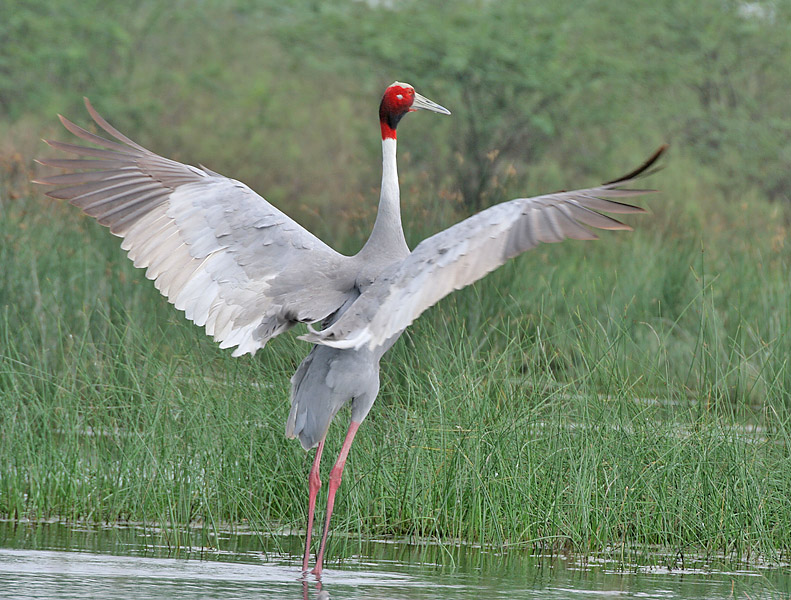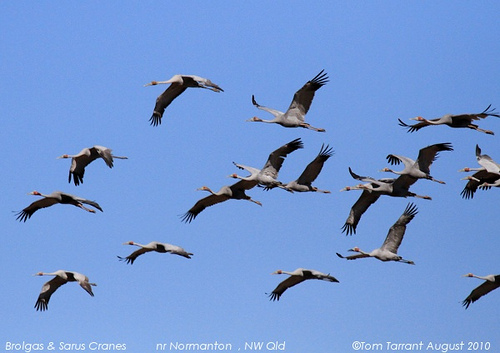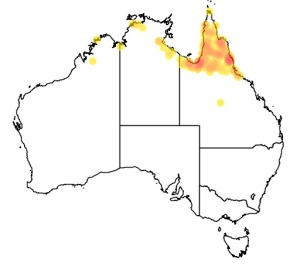Colours
Distinguishing features
The adult Sarus Crane is very large with grey wings and body; a bare red head and part of the upper neck; a greyish crown; and a long greenish-grey pointed bill. In flight, the long neck is held straight, unlike that of an heron, which folds it back, and the black wing tips can be seen; the crane's long pink legs trail behind them. This bird has a grey ear covert patch, an orange-red iris and a greenish-grey bill. Juveniles have a yellowish base to the bill and the brown-grey head is fully feathered.
The bare red skin of the adult's head and neck is brighter during the breeding season. This skin is rough and covered by papillae, and a narrow area around and behind the head is covered by black bristly feathers. The sexes do not differ in plumage although males are on average larger than females; male Sarus of the Indian population can attain a maximum height of about 180 cm making them the world's tallest extant flying bird. Birds from Australia tend to be smaller than birds from the north. (Wikipedia)
Size
- Up to 180 cm (Height)
- Up to 180 cm (Height)
Weight
- From 5 kg to 12 kg
- From 5 kg to 12 kg
Wingspan
- From 220 cm to 250 cm - applies to Adults
- From 220 cm to 250 cm - applies to Adults
Synonyms
Distribution
Distribution and habitat preferences
The species has historically been widely distributed on the lowlands of India along the Gangetic plains, extending south to the Godavari River, west to coastal Gujarat, the Tharparkar District of Pakistan, and east to West Bengal and Assam. The species no longer breeds in the Punjab, though it winters regularly.
Sarus Cranes are rare and occur in very low numbers in West Bengal and Assam, and are no longer found in the state of Bihar. In Nepal, its distribution is restricted to the western lowland plains, with most of the population occurring in Rupandehi, Kapilvastu, and Nawalparasi districts.
There are two distinct populations of Sarus Cranes in South-east Asia: the northern population in China and Burma, and the southern population in Cambodia and Vietnam.
The Sarus used to extend to Thailand and further east into the Philippines, but became extinct. In 2011, captive bred cranes were reintroduced into Thailand.
In Australia they are found only in the northern parts, and are partly migratory in some areas. The global range has shrunk and the largest occupied area is now in India. With marshlands largely destroyed, these cranes are increasingly dependent on wet paddy fields in India.
Sarus Cranes preferentially use wetlands or uncultivated patches amid flooded rice paddies for nesting in India. (Wikipedia)
Diet
Sarus Cranes forage in shallow water (usually with less than 30 cm depth of water) or in fields, frequently probing in mud with their long bills. They are omnivorous, eating insects (especially grasshoppers), aquatic plants, fish (perhaps only in captivity), frogs, crustaceans and seeds. Occasionally tackling larger vertebrate prey such as water snakes. (Wikipedia)



